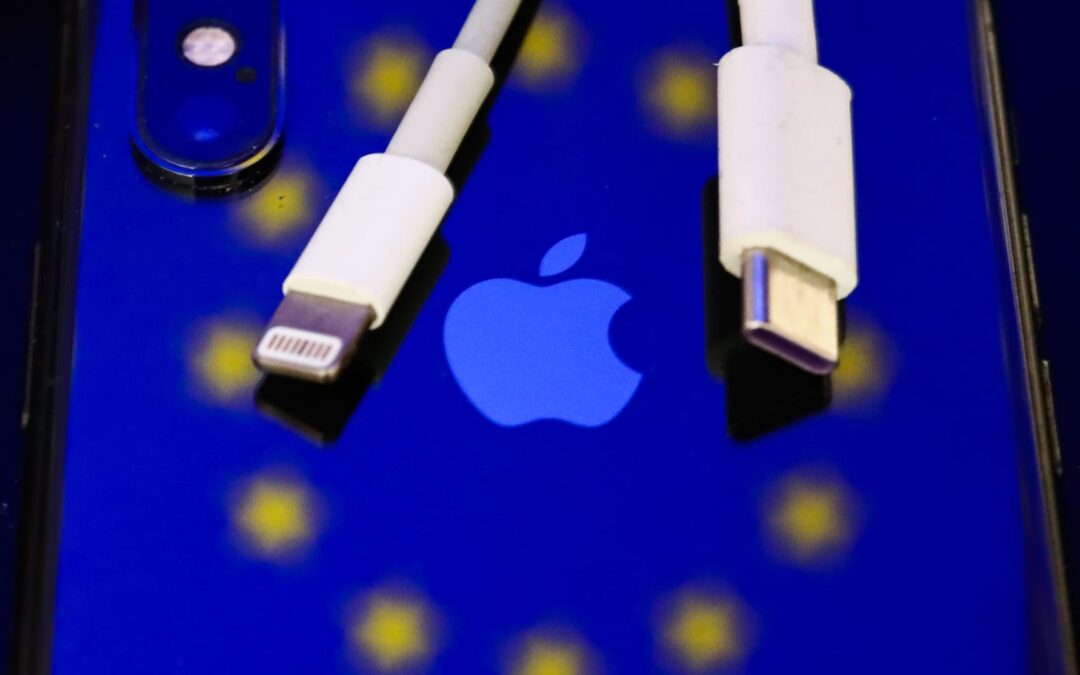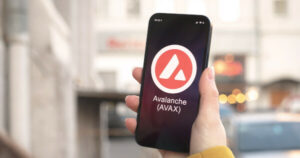Apple will “comply” with European Union regulation that requires electronic devices to be equipped with USB-C charging, said Greg Joswiak, Apple’s senior vice president of worldwide marketing. That will mean Apple’s iPhones, which currently use its proprietary Lightning charging standard, will need to change to support USB-C.
Jakub Porzyck | Nurphoto | Getty Images
The next iPhones, expected in September as usual, could have a feature that no iPhone has ever had: a generic charging port.
The new iPhone models could include a USB Type-C charger port on the phone’s bottom, according to analysts and media reports. That’s the same charging port that’s used on nearly every laptop sold in the past few years, as well as Android phones, iPads, and other gadgets from Kindles to headphones to drones and heated blankets.
The USB-C connector would replace Apple’s proprietary port, the Lightning port, which has graced the bottom of every iPhone model released since 2012.
The shift would be one of the biggest improvements to the iPhone in years for consumers.
IPhone users would no longer need to bring two different cables for their phone and other gadgets while traveling. Android users could borrow chargers from people who own iPhones. IPhone users could borrow chargers from anyone using a newer laptop. Schools and businesses could standardize on one type of charger for their entire fleet of devices. USB-C could even allow iPhones to access faster charging speeds.
While Apple hasn’t confirmed that its new iPhones will feature a USB-C charging port, and didn’t respond to a request for comment, the change is bound to happen.
A new regulation passed by the European Union last year requires USB-C ports on new smartphones by 2024. Apple is unlikely to produce an iPhone model solely for the European market. “Obviously, we’ll have to comply,” Greg Joswiak, Apple’s chief marketer, said last year.
Consumer benefits, like the reduced “lock-in” to a single manufacturer, helped form the reasoning behind the new regulations. The EU estimates the rule could save Europeans 250 million euros per year on chargers. The EU also said old chargers account for about 11,000 tons of e-waste per year in the region.
Apple opposed the law. In a 2021 letter, Apple said that the regulation would hamper future charging innovation, could require it to take devices off the market early, and could confuse consumers with additional information.
“We are concerned that regulation mandating just one type of connector for all devices on the market will harm European consumers by slowing down the introduction of beneficial innovations in charging standards, including those related to safety and energy efficiency,” Apple said in the letter.
USB Type-C hub connected to a laptop with cables connected for peripheral computer device equipment
Pavel Balanenko | Getty Images
Whenever Apple changes the ports on its devices, skeptics believe it’s just an effort to make more money on its premium-priced cables. Apple’s most capable USB-C cable retails for $39.
For example, when Apple added USB-C chargers to MacBook laptops starting in 2015, it drew jokes about the dongles required to plug older accessories into the new laptops.
When Apple removed the headphone jack from the iPhone in 2016, it spurred months of commentary, both for and against the “courageous” change, about whether Apple was pushing people to its more expensive wireless AirPods. It still inspires takes today about whether it was the right decision; most Android phones have followed suit.
But while Apple makes money from its cables, and has a program where accessory makers pay for access and official Apple parts called “MFi,” Apple’s strategic focus is making sure that its products work together without major flaws so its users continue to buy new iPhones. It’s not nickel-and-diming dongles and accessories.
Cable sales are reported in Apple’s Wearables, Home, and Accessories product line, which reported $41 billion in revenue in 2022, although Apple Watches and headphones make up the majority of the sales. That’s much smaller than the $205 billion in iPhone sales Apple reported during the year.
Possible downsides
Apple’s argument that a new charger will cause confusion holds more water. With the Lightning port, companies that wanted to make officially approved accessories have to apply for Apple’s program, and pay for access to specifications and official Apple parts. For consumers, this meant that while there were a few knockoff Lightning devices to avoid, at most stores, the dock or clock or cable users purchased would just work.
USB-C is a different beast. It’s a “standard,” which means the exact specifications are published by a group of companies and individuals working together. Anyone can use those specifications to build cables, and you don’t need to enroll in an Apple-administered program.
This also means that many iPhone users will learn that not all cables with a USB-C connector are created equal. Some cables can transfer data quickly, and some can’t. Back when the standard was first introduced, some cables could even cause damage to devices because they were misconfigured, though this hasn’t been as common in recent years. Some cables even support “Thunderbolt,” a modern data transfer standard for powerful accessories such as monitors or docks, although at a higher price. There are websites that test and approve cables that are “compliant” with the USB-C standard.
Apple will likely let users know if a cable is appropriate for charging an iPhone, through software warnings, what it carries at its retail operation, and through its MFi program.
But it’s clear that the charger port switch raises possibilities for frustrating situations that didn’t exist when Apple stuck with its proprietary charger. Apple’s current troubleshooting document for USB-C charging issues on Mac tells users to test with Apple’s official cables and power adapters.
The world won’t change overnight when Apple’s iPhones have USB-C ports. Apple still develops some of its own proprietary charging standards, such as MagSafe, which uses magnets to affix a charging puck to the back of an iPhone. Its Apple Watch uses a unique magnetic charger as well. Even after using USB-C as the only charging port on its MacBook laptops for years, Apple recently introduced a proprietary magnetic charger on recent models.
Eventually, Apple watchers predict, the company is likely to try to remove ports entirely from the iPhone, but until then, Apple aficionados with multiple products will still need to carry several different charging cables.
Still, the USB-C port is a step in the right direction for iPhone users, even if Apple is grumbling along the way. Apple preferred an approach that would standardize charging bricks but allow cables to be specific for a type of device.
“What that allows you to do is have over a billion people — it’s not a small number of people have that connector on the left [pointing to the Lightning cable] — to be able to use what they have already, and not have to be disrupted,” Apple’s senior vice president of worldwide marketing, Greg Jozwiak, said in 2022.







